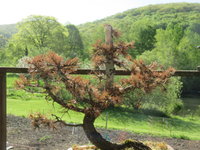Javaman4373
Shohin
Over 20 years ago I planted about 10 bristlecone pine seedlings in various places in the nearby landscape. We have clay subsoil and many areas are wet and even swampy. All those B. pines died except one that was on a well drained sloping area below my blue berry patch. So one day I choped the tall trunk back and collected the tree and potted it. It rather promptly died, of root rot. No doubt I kept it too wet, especially considering it is a desert loving species and I kept too much of the original soil. It could have been an interesting tree and was a hard lesson. Whoops, ended up in wrong forum.


